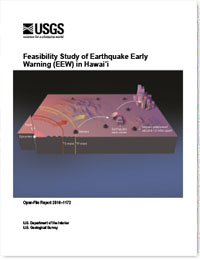Feasibility study of earthquake early warning (EEW) in Hawaii
Links
- Document: Report (2.6 MB pdf)
- Download citation as: RIS | Dublin Core
Abstract
The effects of earthquake shaking on the population and infrastructure across the State of Hawaii could be catastrophic, and the high seismic hazard in the region emphasizes the likelihood of such an event. Earthquake early warning (EEW) has the potential to give several seconds of warning before strong shaking starts, and thus reduce loss of life and damage to property. The two approaches to EEW are (1) a network approach (such as ShakeAlert or ElarmS) where the regional seismic network is used to detect the earthquake and distribute the alarm and (2) a local approach where a critical facility has a single seismometer (or small array) and a warning system on the premises.
The network approach, also referred to here as ShakeAlert or ElarmS, uses the closest stations within a regional seismic network to detect and characterize an earthquake. Most parameters used for a network approach require observations on multiple stations (typically 3 or 4), which slows down the alarm time slightly, but the alarms are generally more reliable than with single-station EEW approaches. The network approach also benefits from having stations closer to the source of any potentially damaging earthquake, so that alarms can be sent ahead to anyone who subscribes to receive the notification. Thus, a fully implemented ShakeAlert system can provide seconds of warning for both critical facilities and general populations ahead of damaging earthquake shaking.
The cost to implement and maintain a fully operational ShakeAlert system is high compared to a local approach or single-station solution, but the benefits of a ShakeAlert system would be felt statewide—the warning times for strong shaking are potentially longer for most sources at most locations.
The local approach, referred to herein as “single station,” uses measurements from a single seismometer to assess whether strong earthquake shaking can be expected. Because of the reliance on a single station, false alarms are more common than when using a regional network of seismometers. Given the current network, a single-station approach provides more warning for damaging earthquakes that occur close to the station, but it would have limited benefit compared to a fully implemented ShakeAlert system. For Honolulu, for example, the single-station approach provides an advantage over ShakeAlert only for earthquakes that occur in a narrow zone extending northeast and southwest of O‘ahu. Instrumentation and alarms associated with the single-station approach are typically maintained and assessed within the target facility, and thus no outside connectivity is required. A single-station approach, then, is unlikely to help broader populations beyond the individuals at the target facility, but they have the benefit of being commercially available for relatively little cost.
The USGS Hawaiian Volcano Observatory (HVO) is the Advanced National Seismic System (ANSS) regional seismic network responsible for locating and characterizing earthquakes across the State of Hawaii. During 2014 and 2015, HVO tested a network-based EEW algorithm within the current seismic network in order to assess the suitability for building a full EEW system. Using the current seismic instrumentation and processing setup at HVO, it is possible for a network approach to release an alarm a little more than 3 seconds after the earthquake is recorded on the fourth seismometer. Presently, earthquakes having M≥3 detected with the ElarmS algorithm have an average location error of approximately 4.5 km and an average magnitude error of -0.3 compared to the reviewed catalog locations from the HVO. Additional stations and upgrades to existing seismic stations would serve to improve solution precision and warning times and additional staffing would be required to provide support for a robust, network-based EEW system.
For a critical facility on the Island of Hawaiʻi, such as the telescopes atop Mauna Kea, one phased approach to mitigate losses could be to immediately install a single station system to establish some level of warning. Subsequently, supporting the implementation of a full network-based EEW system on the Island of Hawaiʻi would provide additional benefit in the form of improved warning times once the system is fully installed and operational, which may take several years.
Distributed populations across the Hawaiian Islands, including those outside the major cities and far from the likely earthquake source areas, would likely only benefit from a network approach such as ShakeAlert to provide warnings of strong shaking.
Suggested Citation
Thelen, W.A., Hotovec-Ellis, A.J., Bodin, P., 2016, Feasibility study of earthquake early warning (EEW) in Hawaii: U.S. Geological Survey Open-File Report 2016–1172, 33 p., https://dx.doi.org/10.3133/ofr20161172.
ISSN: 2331-1258 (online)
Study Area
Table of Contents
- Executive Summary
- Introduction
- Current State of the Seismic Network
- Theoretical Performance of ElarmS and a Single Station Within the Current Network
- Steps Toward Full EEW Implementation
- ElarmS Compared to a Single-Station Approach
- Summary
- References Cited
| Publication type | Report |
|---|---|
| Publication Subtype | USGS Numbered Series |
| Title | Feasibility study of earthquake early warning (EEW) in Hawaii |
| Series title | Open-File Report |
| Series number | 2016-1172 |
| DOI | 10.3133/ofr20161172 |
| Publication Date | September 30, 2016 |
| Year Published | 2016 |
| Language | English |
| Publisher | U.S. Geological Survey |
| Publisher location | Reston, VA |
| Contributing office(s) | Volcano Science Center |
| Description | iii, 30 p. |
| Country | United States |
| State | Hawaii |
| Online Only (Y/N) | Y |


